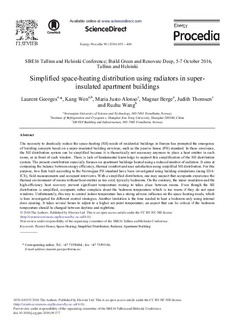| dc.contributor.author | Georges, Laurent | |
| dc.contributor.author | Wen, Kang | |
| dc.contributor.author | Alonso, Maria Justo | |
| dc.contributor.author | Berge, Magnar | |
| dc.contributor.author | Thomsen, Judith | |
| dc.contributor.author | Wang, Ruzhu | |
| dc.date.accessioned | 2017-09-07T11:10:17Z | |
| dc.date.available | 2017-09-07T11:10:17Z | |
| dc.date.created | 2016-12-08T12:49:46Z | |
| dc.date.issued | 2016 | |
| dc.identifier.citation | Energy Procedia. 2016, 96 455-466. | nb_NO |
| dc.identifier.issn | 1876-6102 | |
| dc.identifier.uri | http://hdl.handle.net/11250/2453557 | |
| dc.description.abstract | The necessity to drastically reduce the space-heating (SH) needs of residential buildings in Europe has prompted the emergence of building concepts based on a super-insulated building envelope, such as the passive house (PH) standard. In these envelopes, the SH distribution system can be simplified because it is theoretically not necessary anymore to place a heat emitter in each room, or in front of each window. There is lack of fundamental knowledge to support this simplification of the SH distribution system. The present contribution especially focuses on apartment buildings heated using a reduced number of radiators. It aims at comparing the balance between energy efficiency, thermal comfort and user satisfaction using simplified SH distribution. For this purpose, two flats built according to the Norwegian PH standard have been investigated using building simulations (using IDA-ICE), field measurements and occupant interviews. With a simplified distribution, one may suspect that occupants experience the thermal environment of rooms without heat emitter as too cold, typically bedrooms. On the contrary, the super-insulation and the high-efficiency heat recovery prevent significant temperature zoning to takes place between rooms. Even though the SH distribution is simplified, occupants rather complain about the bedroom temperature which is too warm if they do not open windows. Unfortunately, this way to control indoor temperature has a strong adverse influence on the space-heating needs, which is here investigated for different control strategies. Another limitation is the time needed to heat a bedroom only using internal door opening. It takes several hours to adjust to a higher set-point temperature; an aspect that can be critical if the bedroom temperature should be changed between daytime and nighttime. | nb_NO |
| dc.language.iso | eng | nb_NO |
| dc.publisher | Elsevier | nb_NO |
| dc.rights | Attribution-NonCommercial-NoDerivatives 4.0 Internasjonal | * |
| dc.rights.uri | http://creativecommons.org/licenses/by-nc-nd/4.0/deed.no | * |
| dc.title | Simplified Space-heating Distribution Using Radiators in Super-insulated Apartment Buildings | nb_NO |
| dc.type | Journal article | nb_NO |
| dc.type | Peer reviewed | nb_NO |
| dc.description.version | publishedVersion | nb_NO |
| dc.source.pagenumber | 455-466 | nb_NO |
| dc.source.volume | 96 | nb_NO |
| dc.source.journal | Energy Procedia | nb_NO |
| dc.identifier.doi | 10.1016/j.egypro.2016.09.177 | |
| dc.identifier.cristin | 1410141 | |
| dc.description.localcode | © 2016 The Authors. Published by Elsevier Ltd. This is an open access article under the CC BY-NC-ND license (http://creativecommons.org/licenses/by-nc-nd/4.0/) | nb_NO |
| cristin.unitcode | 194,64,25,0 | |
| cristin.unitcode | 194,61,25,0 | |
| cristin.unitname | Institutt for energi- og prosessteknikk | |
| cristin.unitname | Institutt for byggekunst, historie og teknologi | |
| cristin.ispublished | true | |
| cristin.fulltext | original | |
| cristin.qualitycode | 1 | |

